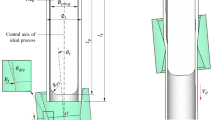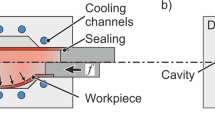Abstract
Quality is a very important feature in the manufacturing of products such as tube. Nonhomogeneous deformation, common to most metalforming operations, leaves the product in a cold worked state, resulting in a pattern of residual stresses. Depending on the nature and magnitude of residual stresses, they may be detrimental or beneficial to the strength and reliability of the product. To evaluate the residual stresses in the product, a complete stress analysis of the workpiece throughout the deformation history is required. In this study, a large deformation, nonlinear, elastic-plastic finite-element code was used to investigate the effect of friction, drawing speed, degree of plastic work (reduction in area), and the die/plug geometry on the extent of temperature increase, induced residual stresses, and the required drawing load in the drawing of oxygen-free high-conductivity (OFHC) copper tube using a fixed, tapered plug. Complete simulations of the tube drawing process were conducted by tracing its deformation history from the point at which it entered the die area until it exited the die. The resulting thermal effects were then used to determine the required drawing loads and induced residual stress distributions throughout the tube wall thickness. Similar simulations were conducted without taking into account the thermal effects. Equivalent plastic strain, equivalent stress, longitudinal stress, and circumferential residual stresses are presented and compared for both the isothermal and the thermally coupled analysis.
Similar content being viewed by others
References
D.S. Chapman, “Effect of Process Variables on the Tube Drawing Process and Product Integrity,” thesis, Texas Tech University, Lubbock, TX (1991).
H.D. Hibbit, Karlsson, and Sorenson, “ABAQUS Theory Manual,” Version 4.7, Hibbit Karlsson and Sorenson Inc., Providence, RI (1989).
R. Kopp and M.L. Cho, “Influences of the Boundary Conditions on Results of the Finite-Element-Simulations,” Proc. Second Int. Conf. Technology of Plasticity, Vol 1, Stuttgart, Germany, 43-50 (1987).
H.D. Hibbit, Karlsson, and Sorenson, “ABAQUS Users Manual,” Version 4.7, Hibbit Karlsson and Sorenson Inc., Providence, RI (1989).
T. Altan and F.W. Boulger, “Flow Stress of Metal and Its Application in Metal Forming Analysis,”J. Eng. Ind., Nov, 1009-1019 (1973).
E. Voce, “The Relationship Between Stress and Strain for Homogeneous Deformation,”Int. Inst. Met., 74, 537 (1948).
C.S. Hartley and R. Srinivasan, “Constitutive Equations for Large Plastic Deformations of Metals,”J. Eng. Mater. Technol., 105, July, 162–167 (1983).
C.S. Hartley, “Optimum Processing Parameters for Floating Plug Tube Drawing,” Proc. NAMRC VI, Society of Manufacturing Engineers, Apr 16-19, 193-198 (1978). O.C. Zienkiewicz, E. Onate, and J.C. Heinrich, “A General For- mulation for Coupled Thermal Flow of Metals Using Finite Element,”Int. J. Numerical Methods Eng., 1, 75-100 (1981). H.D. Hibbit, Karlsson, and Sorenson, “ABAQUS Example Problems Manual,” Version 4.7, Hibbit Karlsson and Sorenson Inc., Providence, RI (1989). the Finite-Element Simulations,” Proceeding, Second International Conference on Technology of Plasticity, Stuttgart, Germany, Vol. 1, pp. 43–50
Author information
Authors and Affiliations
Rights and permissions
About this article
Cite this article
Rasty, J., Chapman, D. Isothermal and thermomechanical finite-element analysis of the tube drawing process using a fixed tapered plug. JMEP 1, 547–554 (1992). https://doi.org/10.1007/BF02682692
Published:
Issue Date:
DOI: https://doi.org/10.1007/BF02682692




